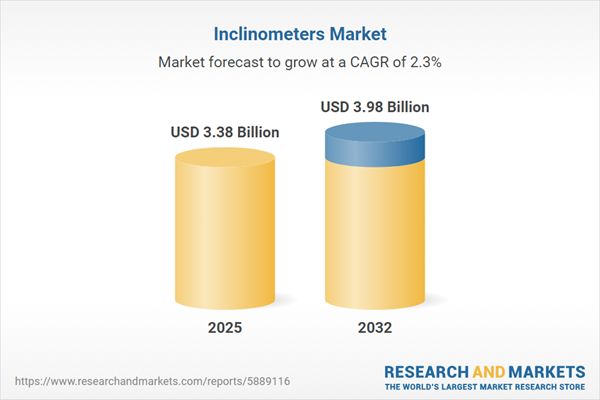Speak directly to the analyst to clarify any post sales queries you may have.
The global inclinometer market is advancing rapidly as new technologies and regulatory shifts redefine the value of precise angular measurement for industries worldwide. Senior decision-makers benefit from detailed insights that address evolving supply chain conditions and support long-term strategic planning.
Market Snapshot: Inclinometers Market Growth and Momentum
The Inclinometers Market grew from USD 3.31 billion in 2024 to USD 3.38 billion in 2025. It is expected to continue growing at a CAGR of 2.33%, reaching USD 3.98 billion by 2032. This reflects sustained demand for high-precision sensing across sectors including aerospace, construction, automotive, energy, and emerging digital infrastructures. Rising investments in connected systems, advances in sensor miniaturization, and the influence of new tariff measures have positioned the industry at a pivotal transition for sustained innovation and cross-vertical adoption.
Scope & Segmentation
- Technology Types: Capacitive, electrolytic, and MEMS (bulk machining, surface machining) inclinometers for varied precision and application needs.
- Application Verticals: Sectors covered include aerospace, automotive (conventional and electric vehicles), construction, consumer electronics, oil and gas, and renewable energy (hydroelectric, solar, and wind projects).
- Axis Orientation: Single axis, dual axis, and triple axis designs cater to distinct use cases ranging from level detection to full spatial monitoring.
- Installation Methods: Permanent installations for structural health monitoring, and portable models for field inspections or mobile assets.
- Output Formats: Analog outputs for legacy environments and digital interfacing supporting modern control networks.
- Regional Markets: Comprehensive coverage across the Americas (North and Latin America), Europe, Middle East & Africa (split by Europe, Middle East, Africa), and Asia-Pacific.
- Leading Companies Profiled: Detailed analysis includes TE Connectivity Ltd., Murata Manufacturing Co., Ltd., Honeywell International Inc., SICK AG, Micro-Epsilon Messtechnik GmbH & Co. KG, Hottinger Baldwin Messtechnik GmbH, Kistler Instrumente AG, KROHNE Messtechnik GmbH, Jewell Instruments, Inc., and RST Instruments Ltd.
Key Takeaways for Senior Decision-Makers
- Advanced microelectromechanical systems (MEMS) are elevating the reliability and sensitivity of modern inclinometer solutions, supporting their integration into critical infrastructure and industrial automation projects.
- Strategic alliances between component manufacturers and system integrators deliver turnkey solutions that unify sensing, data acquisition, and analytics—improving asset management and monitoring efficiencies for industrial clients.
- Regulatory complexity, particularly in sectors such as oil and gas, drives demand for heightened calibration standards and ruggedized sensor platforms, expanding service-oriented revenue streams for vendors.
- Digital transformation initiatives across diverse geographies enhance demand for both miniaturized and connected inclinometer devices, with regional variations in technology adoption and supply chain priorities impacting deployment strategies.
- Emergence of digital twins and real-time condition monitoring is reshaping traditional value propositions, with established and start-up firms alike seeking to expand software and platform capabilities.
Tariff Impact: Navigating Trade and Supply Chain Shifts
Recent United States tariffs on semiconductor wafers and sensor packaging materials have introduced new cost drivers for global manufacturers. Industry participants are responding through diversification, including the assessment of nearshoring and renegotiation of supply agreements to address cost volatility. These dynamics influence pricing models, vendor collaboration strategies, and risk-sharing mechanisms, shaping procurement and logistics plans for the foreseeable future.
Inclinometer Market: Methodology & Data Sources
Analysis is based on a robust framework combining primary interviews with manufacturers and experts, as well as secondary research from technical journals and white papers. Stakeholder input is triangulated with quantitative market data and validated using scenario and sensitivity analyses. Company profiling encompasses patent review, launch activity, and partnership tracking.
Inclinometers Market: Why This Report Matters
- Equips executives with granular insights to inform procurement, supply chain resilience, and strategic technology selection amid regulatory and trade disruptions.
- Supports cross-functional planning with up-to-date intelligence on innovation cycles, partnership models, and the implications of digital transformation across industry segments and regions.
Conclusion
The inclinometer market’s ongoing transformation is driven by technology advancements, new trade policy considerations, and evolving application needs. Decision-makers can leverage this report to align strategies with emerging opportunities, foster innovation, and maintain agility in a rapidly shifting competitive landscape.
Additional Product Information:
- Purchase of this report includes 1 year online access with quarterly updates.
- This report can be updated on request. Please contact our Customer Experience team using the Ask a Question widget on our website.
Table of Contents
3. Executive Summary
4. Market Overview
7. Cumulative Impact of Artificial Intelligence 2025
Companies Mentioned
The companies profiled in this Inclinometers market report include:- TE Connectivity Ltd.
- Murata Manufacturing Co., Ltd.
- Honeywell International Inc.
- SICK AG
- Micro-Epsilon Messtechnik GmbH & Co. KG
- Hottinger Baldwin Messtechnik GmbH
- Kistler Instrumente AG
- KROHNE Messtechnik GmbH
- Jewell Instruments, Inc.
- RST Instruments Ltd.
Table Information
| Report Attribute | Details |
|---|---|
| No. of Pages | 184 |
| Published | October 2025 |
| Forecast Period | 2025 - 2032 |
| Estimated Market Value ( USD | $ 3.38 Billion |
| Forecasted Market Value ( USD | $ 3.98 Billion |
| Compound Annual Growth Rate | 2.3% |
| Regions Covered | Global |
| No. of Companies Mentioned | 11 |









